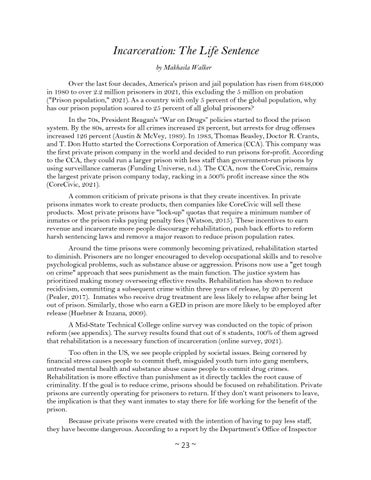Incarceration: The Life Sentence by Makhaila Walker Over the last four decades, America's prison and jail population has risen from 648,000 in 1980 to over 2.2 million prisoners in 2021, this excluding the 5 million on probation ("Prison population," 2021). As a country with only 5 percent of the global population, why has our prison population soared to 25 percent of all global prisoners? In the 70s, President Reagan's “War on Drugs” policies started to flood the prison system. By the 80s, arrests for all crimes increased 28 percent, but arrests for drug offenses increased 126 percent (Austin & McVey, 1989). In 1983, Thomas Beasley, Doctor R. Crants, and T. Don Hutto started the Corrections Corporation of America (CCA). This company was the first private prison company in the world and decided to run prisons for-profit. According to the CCA, they could run a larger prison with less staff than government-run prisons by using surveillance cameras (Funding Universe, n.d.). The CCA, now the CoreCivic, remains the largest private prison company today, racking in a 500% profit increase since the 80s (CoreCivic, 2021). A common criticism of private prisons is that they create incentives. In private prisons inmates work to create products, then companies like CoreCivic will sell these products. Most private prisons have "lock-up" quotas that require a minimum number of inmates or the prison risks paying penalty fees (Watson, 2015). These incentives to earn revenue and incarcerate more people discourage rehabilitation, push back efforts to reform harsh sentencing laws and remove a major reason to reduce prison population rates. Around the time prisons were commonly becoming privatized, rehabilitation started to diminish. Prisoners are no longer encouraged to develop occupational skills and to resolve psychological problems, such as substance abuse or aggression. Prisons now use a "get tough on crime" approach that sees punishment as the main function. The justice system has prioritized making money overseeing effective results. Rehabilitation has shown to reduce recidivism, committing a subsequent crime within three years of release, by 20 percent (Pealer, 2017). Inmates who receive drug treatment are less likely to relapse after being let out of prison. Similarly, those who earn a GED in prison are more likely to be employed after release (Huebner & Inzana, 2009). A Mid-State Technical College online survey was conducted on the topic of prison reform (see appendix). The survey results found that out of 8 students, 100% of them agreed that rehabilitation is a necessary function of incarceration (online survey, 2021). Too often in the US, we see people crippled by societal issues. Being cornered by financial stress causes people to commit theft, misguided youth turn into gang members, untreated mental health and substance abuse cause people to commit drug crimes. Rehabilitation is more effective than punishment as it directly tackles the root cause of criminality. If the goal is to reduce crime, prisons should be focused on rehabilitation. Private prisons are currently operating for prisoners to return. If they don’t want prisoners to leave, the implication is that they want inmates to stay there for life working for the benefit of the prison. Because private prisons were created with the intention of having to pay less staff, they have become dangerous. According to a report by the Department’s Office of Inspector
~ 23 ~






